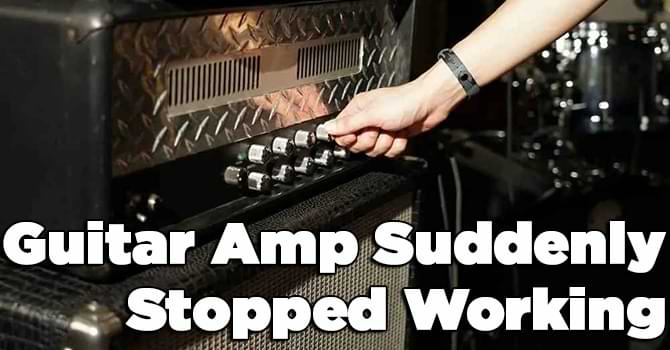Guitar Amp Suddenly Stopped Working [Reason & Fix]
Imagine this scenario: you’re in the midst of a jam session or about to perform on stage, and your reliable guitar amp suddenly quits. It’s an exasperating situation, leaving you feeling bewildered and powerless. But don’t worry! We’ll delve into the reasons behind your guitar amp’s unexpected shutdown and offer detailed solutions to revive it.

Whether you’re a seasoned guitarist or just starting your musical journey, this guide will provide you with the expertise to diagnose & resolve your amp problems. Let’s delve into the realm of amplifiers and demystify their sudden malfunctions.
# Table of Contents =>
Step by Step Fix: Guitar Amp Suddenly Stopped Working –
a) Power Supply Issues:

Power supply issues are frequently to blame when a guitar amp abruptly ceases to function. These issues encompass blown fuses, malfunctioning power cables, and outlet-related problems.
Blown Fuses:
Fuses serve as a safeguard against power surges, shielding your amp. When a fuse blows, it interrupts the power supply to your amp. To address this, identify the blown fuse, substitute it with a new one having the identical rating, and investigate the underlying reason behind the blown fuse.
Faulty Power Cables:
Sometimes, the power cable connecting your amp to the outlet can be damaged. Check for visible wear or fraying and replace the cable if necessary.
Outlet Problems:
Ensure that the outlet you’re using is functioning correctly. Plug in another device to confirm. If the outlet is the issue, contact an electrician to fix it.
Solutions and Fixes:
Regularly check and replace fuses if needed. Use high-quality power cables, and consider investing in a surge protector to safeguard your amp from power spikes.
b) Tube & Component Problems:

Tubes are a crucial part of many guitar amps, and they can fail over time. Other components like capacitors and resistors can also be the culprits when your amp suddenly stops working.
Tube Failure:
Tubes can become worn out or blow due to prolonged use. If you suspect tube failure, visually inspect them for damage or test them with a tube tester. Replace any faulty tubes with new ones of the same type.
Capacitor Issues:
Capacitors can degrade over time, affecting the amp’s performance. Look for swollen or leaking capacitors on the circuit board. Replacing damaged capacitors with high-quality replacements can solve the issue.
Resistor Problems:
Resistors can also fail or become damaged. Use a multimeter to check their resistance values. If you find any resistors with values significantly different from their rating, they may need replacement.
Solutions and Fixes:
Regularly maintain your amp’s tubes, and consider replacing them periodically for optimal performance. If you’re not experienced in amp repair, consult a technician for tube and component replacement. Hopefully, it is the way of solution if Guitar Amp Suddenly Stopped Working.
c) Speaker & Output Problems:

The speaker and output components of your amp are responsible for producing sound. Problems with these can lead to sudden amp failures.
Speaker Damage:
Check for visible damage to the speaker cone or surround. If you hear rattling or distorted sound, it may be a sign of a damaged speaker.
Output Transformer Failure:
Output transformers can fail due to overheating or age. If your amp produces no sound, this component might be the issue.
Solutions and Fixes:
Replace damaged speakers with suitable replacements, ensuring they match the impedance and power rating of your amp. For output transformer issues, professional repair or replacement is recommended.
d) Preamp & Input Problems:
The preamp section of your amp is responsible for shaping your guitar’s tone. Issues in this area can lead to a sudden loss of sound or distorted sound.
Dirty or Loose Input Jacks:

Over time, input jacks can accumulate dust and debris, leading to poor connections. Cleaning them or tightening loose connections can resolve the problem.
Potentiometer Issues:
Potentiometers (pot) control various settings on your amp, such as volume and tone. If they become scratchy or unresponsive, they need cleaning or replacement.
Solutions and Fixes:
Regularly clean input jacks and pots with electronic contact cleaner. If cleaning doesn’t resolve the issue, replace the affected components.
e) Wiring & Soldering Failures:
Wiring and soldering issues can cause a variety of problems in your amp, from intermittent sound to complete failure.
Loose Wiring:
Check for loose or disconnected wires in your amp’s circuit. Reconnect any loose wires and secure them properly.
Cold Solder Joints:
Cold solder joints can result from poor soldering during manufacturing or repairs. Inspect the solder joints on the circuit board for any dull or cracked connections and re-solder them if needed.
Solutions and Fixes:
Regularly inspect your amp’s internal wiring and solder joints. Properly secure any loose connections, and re-solder cold joints for a reliable electrical connection.
f) Troubleshooting Steps:
When your amp suddenly stops working, a systematic approach to troubleshooting can help pinpoint the issue. Start by checking the power supply, then move on to tubes and components, followed by the speaker and output components, and finally the preamp and input areas.
Use a multimeter to measure resistance and voltage where necessary. If you’re unsure about any step, consult your amp’s user manual or seek guidance from a professional technician.
Regular Maintenance:
Preventing sudden amp failures begins with regular maintenance. Keep your amp in a clean and dust-free environment. Clean the exterior and interior regularly, paying attention to input jacks, pots, and tubes. Avoid exposing your amp to extreme temperatures and humidity. Consider using a fitted amp cover for added protection. Schedule periodic tube replacement to maintain optimal performance.
Conclusion:
In the world of guitar amplifiers, sudden failures can happen to anyone. However, armed with the knowledge from this ultimate guide, you can confidently diagnose and address these issues. Remember, safety first when dealing with electrical components, and don’t hesitate to seek professional help if you’re unsure about any repair.
Now, you are able way to fix if your Guitar Amp Suddenly Stopped Working. With proper maintenance and care, your guitar amp can provide years of faithful service and keep the music playing. So, keep on jamming, and may your guitar amp troubles be few and easily fixed!
FAQs –
Q. Why did my amp stop working out of nowhere?
Answer: Your amp may have stopped working due to various reasons, such as blown fuses, power supply issues, tube failure, or wiring problems. Identifying the specific cause will require troubleshooting.
Q. Why did my guitar amp stop working?
Answer: Guitar amps can cease functioning due to factors like component failure, electrical issues, or wear and tear. Diagnosing the exact issue involves a systematic assessment.
Q. How do you fix a guitar amp that won’t turn on?
Answer: If your amp won’t power on, start by checking the power source, fuses & power cables. If these are not the culprits, consult a professional technician for further diagnosis and repairs.
Q. How do I know if my guitar amp is blown?
Answer: Signs of a blown guitar amp may include distorted sound, no sound output, or visible damage to components like tubes or capacitors. A technician can confirm if your amp is indeed blown through thorough examination and testing.
Last Updated on September 20, 2023 by Perry Garner


